I have trained a model to figure out if an image is right or wrong (just 2 classes) and I have used the guide on keras website for GradCAM.
The input images are reshaped to (250, 250) and then normalized by dividing the image numpy array by 255. This is then passed for the training of the model.
Here is the code attached. I am encountering the following error: Invalid reduction dimension (1 for input with 1 dimension(s) [Op:Mean]
Data
image = cv2.imread("/content/drive/MyDrive/SendO2/Train/correct/droidcam-20210128-152301.jpg")
image = cv2.resize(image, (250, 250))
image = image.astype('float32') / 255
image = np.expand_dims(image, axis=0)
Model
model = Sequential()
#Adding first convolutional layer
model.add(Conv2D(64, (3,3), activation="relu"))
#Adding maxpooling
model.add(MaxPooling2D((2,2)))
#Adding second convolutional layer and maxpooling
model.add(Conv2D(64, (3,3), activation="relu"))
model.add(MaxPooling2D((2,2)))
#Adding third convolutional layer and maxpooling
model.add(Conv2D(64, (3,3), activation="relu"))
model.add(MaxPooling2D((2,2)))
#Adding fourth convolutional layer and maxpooling
model.add(Conv2D(64, (3,3), activation="relu"))
model.add(MaxPooling2D((2,2)))
#Adding fifth convolutional layer and maxpooling
model.add(Conv2D(64, (3,3), activation="relu"))
model.add(MaxPooling2D((2,2)))
#Flattening the layers
model.add(Flatten())
model.add(Dense(128, input_shape = X.shape[1:], activation="relu"))
#Output Layer. Since, the image is right/wrong, only 2 neurons is needed.
model.add(Dense(2, activation = "softmax"))
# model.add(Dense(2, activation = "sigmoid"))
model.compile(optimizer = "adam", loss = "sparse_categorical_crossentropy", metrics = ["accuracy"])
GradCAM
def get_img_array(img_path, size):
# `img` is a PIL image of size 299x299
img = keras.preprocessing.image.load_img(img_path, target_size=size)
# `array` is a float32 Numpy array of shape (299, 299, 3)
array = keras.preprocessing.image.img_to_array(img)
# We add a dimension to transform our array into a "batch"
# of size (1, 299, 299, 3)
array = np.expand_dims(array, axis=0)
print(array.shape)
return array
def make_gradcam_heatmap(img_array, model, last_conv_layer_name, pred_index=None):
# First, we create a model that maps the input image to the activations
# of the last conv layer as well as the output predictions
grad_model = tf.keras.models.Model(
[model.inputs], [model.get_layer(last_conv_layer_name).output, model.output]
)
# Then, we compute the gradient of the top predicted class for our input image
# with respect to the activations of the last conv layer
with tf.GradientTape() as tape:
last_conv_layer_output, preds = grad_model(img_array)
if pred_index is None:
pred_index = tf.argmax(preds[0])
class_channel = preds[:, pred_index]
# This is the gradient of the output neuron (top predicted or chosen)
# with regard to the output feature map of the last conv layer
grads = tape.gradient(class_channel, last_conv_layer_output)
# This is a vector where each entry is the mean intensity of the gradient
# over a specific feature map channel
pooled_grads = tf.reduce_mean(grads, axis=(0, 1, 2))
# pooled_grads = tf.reduce_mean(grads)
# We multiply each channel in the feature map array
# by "how important this channel is" with regard to the top predicted class
# then sum all the channels to obtain the heatmap class activation
last_conv_layer_output = last_conv_layer_output[0]
heatmap = last_conv_layer_output @ pooled_grads[..., tf.newaxis]
heatmap = tf.squeeze(heatmap)
# For visualization purpose, we will also normalize the heatmap between 0 & 1
heatmap = tf.maximum(heatmap, 0) / tf.math.reduce_max(heatmap)
return heatmap.numpy()
Adjusting parameters
img_size = (250, 250)
preprocess_input = keras.applications.xception.preprocess_input
decode_predictions = keras.applications.xception.decode_predictions
last_conv_layer_name = "dense_1"
# The local path to our target image
img_path = "/content/drive/MyDrive/SendO2/Train/correct/droidcam-20210128-152301.jpg"
preprocess_input = keras.applications.xception.preprocess_input
decode_predictions = keras.applications.xception.decode_predictions
display(Image(img_path))
Running them
# Prepare image
img_array = preprocess_input(get_img_array(img_path, size=img_size))
# Make model
model = model_builder(weights="imagenet")
# Remove last layer's softmax
model.layers[-1].activation = None
# Print what the top predicted class is
preds = model.predict(img_array)
print("Predicted:", decode_predictions(preds, top=1)[0])
# Generate class activation heatmap
heatmap = make_gradcam_heatmap(img_array, model, last_conv_layer_name)
# Display heatmap
plt.matshow(heatmap)
plt.show()
I would really be grateful if anyone can help me out here.



